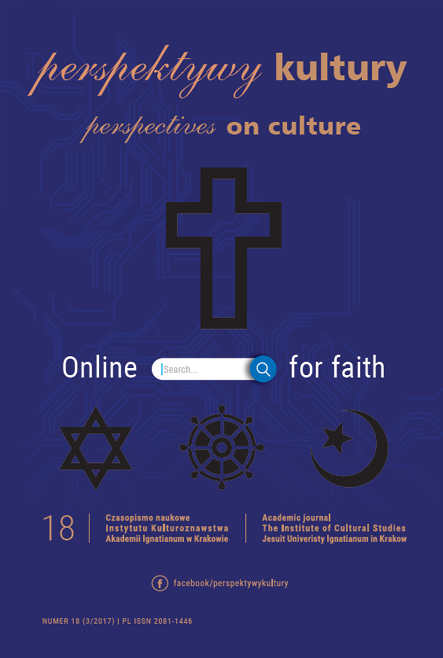(Nie) nowe formy doświadczenia religijnego w świecie cyfrowych technologii
Abstrakt
Celem niniejszej analizy jest wskazanie przykładów religijnych ak- tywności zachodzących w przestrzeni cyfrowych mediów, które czę- sto błędnie nazywane są nowymi. Do nadania im statusu nowości przyczynił się ich związek z komputerem i cyfrowa forma. Ze wzglę- du na ograniczoną objętość, w artykule zostaną jedynie zasygnalizo- wane kwestie związane z analizą praktyk religijnych kształtowanych i wspomaganych przez zmieniające się w czasie media. Przyczynek ten jest punktem wyjścia do szerszego podjęcia tematyki i stanowi przyczynek do szerszych rozważań i pogłębionej analizy różnorod- nych form pobożności zapośredniczonych przez media.
Bibliografia
BEEBE Kathryne. 2014. Pilgrim and Preacher. The Audiences and Observant Spirituality of Friar Felix Fabri (1437/8-1502). Oxford: Oxford University Press.
BADO-FRALICK Nikki, SACHS NORRIS Rebecca. 2015. Games and dolls, In The Routledge Companion to Religion and Popular Culture, J.C. Lyden, E.M. Mazur (ed.), 261-280. Oakland: Routledge.
BRASHER Brenda. 2004. Give Me That Online Religion. New Jersey: Rutgers University Press.
CAMPBELL Heidi A. 2013. Digital Religion: Understanding Religious Practice in New Media Worlds. London: Routledge.
CAMPBELL Heidi A., VITULLO Alessandra. 2016. “Assessing changes in the study of religious communities in digital religion studies”, Church, Communication and Culture 1,1:73-89.
CHUN Wendy Hui Kyong. 2016. Updating to Remain the Same: Habitual New Media. Cambridge: The MIT Press.
ENGLER Rachel Julia. 2017. “Where His Feet Had Trodden: The Space of the “Eastern” Carpet in Hans Memling’s Saint John Altarpiece”, Kon- sthistorisk tidskrift/Journal of Art History, http://dx.doi.org/10.1080/0023 3609.2017.1321040.
FUCHS Mathias. 2016. “Century of Play. 18th Century Precursors of Gam- ification”, Kinephanos, Special issue Exploring the Frontiers of Digital Gaming: Traditional Games, Expressive Games, Pervasive Games 4: 9-33. HENDERSHOT Heather. 2004. Shaking the world for Jesus, Chicago: University of Chicago Press.
KOZINETS Robert V. 2010. Netnography. Doing Ethnographic Research On- line, London:Sage.
LYDEN John C., MAZUR Eric Michael. 2015. The Routledge Companion to Religion and Popular Culture. Abington: Routledge.
MCLUHAN Marshall. 2004. Zrozumieć media. Przedłużenia człowieka. Warszawa: Wydawnictwo Naukowo-Techniczne.
NOWAK Samuel, TASZYCKA Anna. 2010. “Gatunek wobec sacrum. Kry- zys wiary, film grozy i kultura popularna”. Studia Humanistyczne AGH 9: 97-107.
ROUTLEDGE Helen. 2016. Why Games Are Good for Business. How to Le- verage the Power of Serious Games, Gamification and Simulations. London: Palgrave Macmillan.
SACHS NORRIS Rebecca, BADO-FRALICK Nikki. 2010. Toying with God. The World of Religious Games and Dolls. Waco: Baylor University Press.
SMOŁUCHA Danuta. 2016. Kultura religijna w cyberprzestrzeni. Obecność kultu Matki Bożej z Guadalupe w internecie, Kraków: Wydawnictwo WAM. SCOTT Sasha A.Q. 2016. “Algorithmic Absolution. The Case of Catholic Confessional Apps”, Online Heidelberg Journal of Religions on the Internet 11: 254-275.
SPADARO Antonio. 2013. Cyberteologia. Chrześcijaństwo w dobie Internetu, tr. M. Masny. Kraków: Wydawnictwo św. Stanisława BM.
STEIN Rebecca L., STEIN Philip. 2015. Anthropology of Religion, Magic, and Witchcraft. Abingdon: Routledge.
URSYN Anna. 2015. Challenges in Game Design, W Gamification: Concept, Methodologies, Tools, and Application, M. Khosrow-Pour (ed.), 683:698. Hershey: IGI Global.
XIARHOS Michael, “Authenticity and the Cyber Pilgrim”, Journal of Reli- gion & Society 18, 2016, https://dspace2.creighton.edu/xmlui/bitstream/ handle/10504/91849/2016-28.pdf?sequence=1&isAllowed=y.
Copyright (c) 2017 Akademia Ignatianum w Krakowie

Utwór dostępny jest na licencji Creative Commons Uznanie autorstwa – Bez utworów zależnych 4.0 Międzynarodowe.
Autor, zgłaszając swój artykuł, wyraża zgodę na korzystanie przez Wydawnictwo Uniwersystet Ignatianum z utworu na następujących polach eksploatacji:
- utrwalania utworu w formie papierowej, a także na nośniku cyfrowym lub magnetycznym;
- zwielokrotnienia utworu dowolną techniką, bez ograniczenia ilości wydań i liczby egzemplarzy;
- rozpowszechniania utworu i jego zwielokrotnionych egzemplarzy na jakimkolwiek nośniku, w tym wprowadzenia do obrotu, sprzedaży, użyczenia, najmu;
- wprowadzenia utworu do pamięci komputera;
- rozpowszechniania utworu w sieciach informatycznych, w tym w sieci Internet;
- publicznego wykonania, wystawienia, wyświetlenia, odtworzenia oraz nadawania i reemitowania, a także publicznego udostępniania utworu w taki sposób, aby każdy mógł mieć do niego dostęp w miejscu i czasie przez siebie wybranym.
Wydawca zobowiązuje się szanować osobiste prawa autorskie do utworu.





